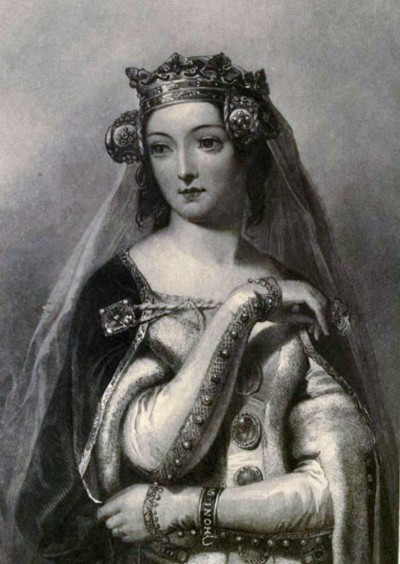Philippa of Hainault (Philippa of Hainault )

Philippa was born in Valenciennes in the County of Hainaut, in the Low Countries, a daughter of William I, Count of Hainaut, Holland and Zeeland, and Joan of Valois, the granddaughter of Philip III of France. She was one of eight children and the second of five daughters. Her eldest sister Margaret married Emperor Louis IV in 1324; and in 1345, she became the suo jure Countess of Hainaut upon the death of their brother William in battle. William II, Count of Hainaut, nicknamed the Audacious, was also possessor of the counties of Zealand and Holland as well as of the seigniory of Frieze: these vacant inheritances were devolved to Margaret after agreement between Philippa and her sister. Edward III of England, however, in 1364–65, in the name of his wife Philippa, demanded the return of Hainaut and other inheritances which had been given over to the Dukes of Bavaria–Straubing. He was not successful, as it was the custom in these regions to favour male heirs.
King Edward II had decided that an alliance with Flanders would benefit England and sent Bishop Stapledon of Exeter on the Continent as an ambassador. On his journey, he crossed into the county of Hainaut to inspect the daughters of Count William of Hainaut, to determine which daughter would be the most suitable as an eventual bride for Prince Edward. The bishop’s report to the king describes one of the count’s daughters in detail. A later annotation says it describes Philippa as a child, but historian Ian Mortimer argues that it is actually an account of her older sister Margaret. Four years later Philippa was betrothed to Prince Edward when, in the summer of 1326, Queen Isabella arrived at the Hainaut court seeking aid from Count William to depose King Edward. Prince Edward had accompanied his mother to Hainaut where she arranged the betrothal in exchange for assistance from the count. As the couple were second cousins, a Papal dispensation was required; and it was sent from Pope John XXII at Avignon in September 1327. Philippa and her retinue arrived in England in December 1327 escorted by her uncle, John of Hainaut. On 23 December she reached London where a “rousing reception was accorded her”.
Philippa married Edward at York Minster, on 24 January 1328, eleven months after his accession to the English throne; although, the de facto rulers of the kingdom were his mother, Queen Dowager Isabella and her avaricious lover Roger Mortimer, 1st Earl of March, who jointly acted as his regents. Soon after their marriage the couple retired to live at Woodstock Palace in Oxfordshire. Unlike many of her predecessors, Philippa did not alienate the English people by retaining her foreign retinue upon her marriage or by bringing large numbers of foreigners to the English court. As Isabella did not wish to relinquish her own status, Philippa’s coronation was postponed for two years. She eventually was crowned queen on 4 March 1330 at Westminster Abbey when she was almost six months pregnant; and she gave birth to her first son, Edward, the following June just nine days before her sixteenth birthday.
In October 1330, King Edward commenced his personal rule when he staged a coup and ordered the arrest of his mother and Mortimer. Shortly afterward, the latter was executed for treason, and Queen Dowager Isabella was sent to Castle Rising in Norfolk, where she spent the remainder of her life. Joshua Barnes, a medieval writer, said “Queen Philippa was a very good and charming person who exceeded most ladies for sweetness of nature and virtuous disposition.” Chronicler Jean Froissart described her as “The most gentle Queen, most liberal, and most courteous that ever was Queen in her days.” Philippa accompanied Edward on his expeditions to Scotland, and the European continent in his early campaigns of the Hundred Years War where she won acclaim for her gentle nature and compassion. She is best remembered as the kind woman who, in 1347, persuaded her husband to spare the lives of the Burghers of Calais, whom he had planned to execute as an example to the townspeople following his successful siege of that city. She acted as regent in England on several occasions when her husband was away from his kingdom. She also influenced the king to take an interest in the nation’s commercial expansion. Philippa was a patron of the chronicler Jean Froissart, and she owned several illuminated manuscripts, one of which currently is housed in the national library in Paris.
Phillipa had given birth to fourteen children and outlived nine of them. Three of her children died of the Black Death in 1348. On 15 August 1369, Philippa died of an illness similar to dropsy in Windsor Castle at the age of fifty-five. She was given a state funeral six months later on 29 January 1370 and interred at Westminster Abbey. Her tomb was placed on the northeast side of the Chapel of Edward the Confessor and on the opposite side of her husband’s grandparents Edward I and Eleanor of Castile and great grandfather Henry III. Her alabaster effigy was beautifully executed by sculptor Jean de Liège. Eight years later Edward III died and was buried next to Philippa. By all accounts, her forty-year marriage to Edward had been happy.
Born
- June, 24, 1314
- Valenciennes, France
Died
- August, 15, 1369
- Windsor Castle, Windsor, Berkshire, England
Cemetery
- Westminster Abbey
- City of Westminster, London, England
- United Kingdom


